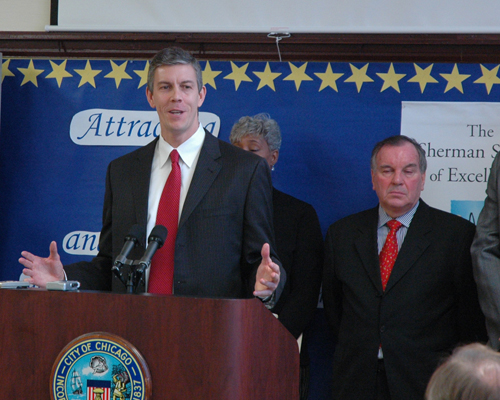University of Chicago report ends myths of mayoral control... Sixteen years after Daley took over city's public schools, elementary test scores have remained flat, while 'achievement' gap has increased!
A massive and detailed report (running to more than 110 pages in its full version) issued on September 30, 2011 by the Consortium on Chicago School Research of the University of Chicago has charged that more than 20 years of various school reforms in Chicago, beginning with the 1988 school reform law (which brought the Local School Councils into existence) and continuing through the 1995 "Amendatory Act" (which gave Chicago's mayor dictatorial control over the city's schools and ushered in the era of "Mayoral Control" for the nation's largest cities) have not only failed to raise student achievement in reading, but have actually hurt the students facing the greatest challenges in their lives, Chicago's poor and segregated minority children.
 On January 31, 2008, one year before he took office as U.S. Secretary of Education, Arne Duncan, who at that time had been in office as Chicago's public schools' "Chief Executive Officer" appeared with Chicago Mayor Richard M. Daley (above right) at the so-called "Sherman School of Excellence." Sherman was one of the first Chicago schools to be turned over through a process called "turnaround" to the Academy for Urban School Leadership (AUSL). At the time, Daley and Duncan were claiming that Sherman had in fact been saved by the "turnaround" process, even though critics were then pointing out that Sherman's test scores had remained roughly the same as other schools in the troubled Englewood community. Substance photo by George N. Schmidt.The report, which was reported in The New York Times and several local media in Chicago but was still being digested and studied as October began, utilized sophisticated statistical methods to compare test scores in reading and math for the city's elementary students between 1988 and 2008, a 20 year period during which Chicago utilized four major tests. The report debunks more than a decade of claims by former Chicago Mayor Richard M. Daley that under his administration the elementary schools of the city had improved measurably, while the problems were still in the city's high schools. In fact, according to the report, the opposite is true.
On January 31, 2008, one year before he took office as U.S. Secretary of Education, Arne Duncan, who at that time had been in office as Chicago's public schools' "Chief Executive Officer" appeared with Chicago Mayor Richard M. Daley (above right) at the so-called "Sherman School of Excellence." Sherman was one of the first Chicago schools to be turned over through a process called "turnaround" to the Academy for Urban School Leadership (AUSL). At the time, Daley and Duncan were claiming that Sherman had in fact been saved by the "turnaround" process, even though critics were then pointing out that Sherman's test scores had remained roughly the same as other schools in the troubled Englewood community. Substance photo by George N. Schmidt.The report, which was reported in The New York Times and several local media in Chicago but was still being digested and studied as October began, utilized sophisticated statistical methods to compare test scores in reading and math for the city's elementary students between 1988 and 2008, a 20 year period during which Chicago utilized four major tests. The report debunks more than a decade of claims by former Chicago Mayor Richard M. Daley that under his administration the elementary schools of the city had improved measurably, while the problems were still in the city's high schools. In fact, according to the report, the opposite is true.
 On September 15, 2008, Chicago Public Schools Chief Executive Officer Arne Duncan (above left) and then Chicago Mayor Richard M. Daley hosted one of their annual media events to announce that the city's elementary test scores had gone "up." The event, held at the Ella Flagg Young school on the city's west side, was held in a library that had almost no books (except those that were placed behind the mayor and Duncan for the photographs) and featured four dozen highly paid CPS executives who were ordered to sit there and cheer the mayor and Duncan about the improved scores on the ISAT tests in reading and math. Substance photo by George N. Schmidt. The report released by the University of Chicago on September 30, 2011, not only outlines the failures of the massive test-based "accountability" program that turned a generation of Chicago public schools teachers and students into lab rats for experimental corporate theories, beginning with the administration of Paul G. Vallas and continuing through the present, but it also undermines that pretentious claims by former Chicago Public Schools CEO Arne Duncan as well. As such, the report, based on the facts of the history of CPS "reforms" now going back 24 years, undermines an entire era of corporate reforms that ignored the basics such as desegregation of schools and lower class size for urban children.
On September 15, 2008, Chicago Public Schools Chief Executive Officer Arne Duncan (above left) and then Chicago Mayor Richard M. Daley hosted one of their annual media events to announce that the city's elementary test scores had gone "up." The event, held at the Ella Flagg Young school on the city's west side, was held in a library that had almost no books (except those that were placed behind the mayor and Duncan for the photographs) and featured four dozen highly paid CPS executives who were ordered to sit there and cheer the mayor and Duncan about the improved scores on the ISAT tests in reading and math. Substance photo by George N. Schmidt. The report released by the University of Chicago on September 30, 2011, not only outlines the failures of the massive test-based "accountability" program that turned a generation of Chicago public schools teachers and students into lab rats for experimental corporate theories, beginning with the administration of Paul G. Vallas and continuing through the present, but it also undermines that pretentious claims by former Chicago Public Schools CEO Arne Duncan as well. As such, the report, based on the facts of the history of CPS "reforms" now going back 24 years, undermines an entire era of corporate reforms that ignored the basics such as desegregation of schools and lower class size for urban children.
The report, which is entitled "Trends in Chicago's Schools Across Three Eras of Reform", was written by Stuart Luppescu, Elaine M. Allensworth, Paul Moore, Maritsa de la Torre, and James Murphy. Because it utilizes fairly sophisticated statistical calculations to compare the different tests that were used to measure Chicago elementary school students' achievement during the 20 year period examined, in its complete version (112 pages printed) is requires some attention. The Consortium has also released a 26-page PDF version and a brief news release summarizing the findings of the study.
The response to the study from one of those whose reputation profited the most from the years of mayoral control was fierce. When reporters caught up with former Chicago Public Schools Chief Executive Officer Paul G. Vallas in Haiti, where he has been hired to help reorganize the nation's school system following the earthquake two years ago. Vallas replied to questions with a typical Vallas one-liner: "What planet are they living on?"
But the report proves in some detail that the general claims made by Vallas during the six years (1995 through 2001) he served as Mayor Daley's schools CEO were simply not true. From the beginning of his term in office (and before it was possible to make any claims about the achievement of CPS students thanks to the "reforms" Vallas had instituted), Vallas and Daley produced regular reports to the public that were, for a couple of years, entitled "Trending Up."
THIS STORY WILL BE COMPLETED BY MIDNIGHT OCTOBER 1, 2011. COMMENTS ARE WELCOME PROVIDED THAT THOSE WHO COMMENT FOLLOW THE SUBSTANCE COMMENT GUIDELINES: First and last names must be used.


By: Rod Estvan
Consortium report
While I have very big concerns about the report in relation to how special education was largely avoided (which I discussed on the D299 blog), this report vindicates critics of CPS's method of reporting academic achievement gains for years. Among those who in my opinion are vindicated in particular are George from Substance, Julie from Pure, and Don Moore from Designs for change.
What else is interesting is that the Consortium has had this data for years and could have released this report two years ago while Daley was still in power. Now that the King is gone they apparently can critically discuss these issues and let the new version of reform start yet again. Up to now the Consortium has avoided looking at contract and charter schools, this is now impossible because of the weight they carry.
The Consortium has access to virtually all CPS testing data and even classroom level data. It has an agreement with CPS and CPS plays a role in the decision making process of the Consortium. Apparently the new CPS leadership effectively gave the green light to the Consortium to publish data analysis it has long had.
While George is correct that the Consortium applied sophisticated statistical methods to equate various tests, I think George and others figured out CPS was not making real progress just by comparing state test data to NAEP data. Even the mainstream media would at various times point this out, but then rapidly forget it to praise progress CPS made under Mayoral control..
How long will it take for the mainstream media to forget this study, not long I bet.
Rod Estvan